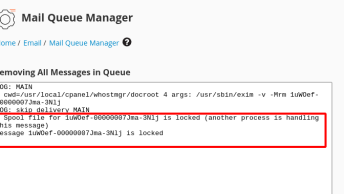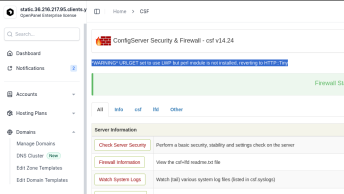There are hundreds of Linux applications on the market, each with their own configuration files and help pages. This variety makes Linux vibrant, but it also makes Linux system administration daunting. Fortunately, in most cases, Linux applications use the Syslog utility to export all their errors and status messages to files located in the /var/log directory.
This can be invaluable in correlating the timing and causes of related events on your system. It is also important to know that applications frequently don’t display errors on the screen, but will usually log them somewhere. Knowing the precise message that accompanies an error can be vital in researching malfunctions in product manuals, online documentation, and Web searches.
syslog, and the logrotate utility that cleans up log files, are both relatively easy to configure but they frequently don’t get their fair share of coverage in most texts.
Syslog
syslog is a utility for tracking and logging all manner of system messages from the merely informational to the extremely critical. Each system message sent to the syslog server has two descriptive labels associated with it that makes the message easier to handle.
- The first describes the function (facility) of the application that generated it. For example, applications such as mail and cron generate messages with easily identifiable facilities named mail and cron.
- The second describes the degree of severity of the message. There are eight in all and they are listed in Table 5-1:
You can configure syslog’s /etc/syslog.conf configuration file to place messages of differing severities and facilities in different files. This procedure will be covered next.
Table 5-1 Syslog Facilities
| Severity Level | Keyword | Description |
| 0 | emergencies | System unusable |
| 1 | alerts | Immediate action required |
| 2 | critical | Critical condition |
| 3 | errors | Error conditions |
| 4 | warnings | Warning conditions |
| 5 | notifications | Normal but significant conditions |
| 6 | informational | Informational messages |
| 7 | debugging | Debugging messages |
The /etc/syslog.conf file
The files to which syslog writes each type of message received is set in the /etc/syslog.conf configuration file. This file consists of two columns. The first lists the facilities and severities of messages to expect and the second lists the files to which they should be logged.
By default, RedHat/Fedora’s /etc/syslog.conf file is configured to put most of the messages in the file /var/log/messages. Here is a sample:
.info;mail.none;authpriv.none;cron.none /var/log/messagesIn this case, all messages of severity “info” and above are logged, but none from the mail, cron or authentication facilities/subsystems. You can make this logging even more sensitive by replacing the line above with one that captures all messages from debug severity and above in the /var/log/messages file. This may be more suitable for troubleshooting.
*.debug /var/log/messagesCertain applications will additionally log to their own application specific log files and directories independent of the syslog.conf file. Here are some common examples:
- Files:
/var/log/maillog : Mail
/var/log/httpd/access_log : Apache web server page access logs- Directories:
/var/log
/var/log/samba : Samba messages
/var/log/mrtg : MRTG messages
/var/log/httpd : Apache webserver messagesNote: In some older versions of Linuxthe /etc/syslog.conf file was very sensitive to spaces and would recognize only tabs. The use of spaces in the file would cause unpredictable results. Check the formatting of your /etc/syslog.conffile to be safe.
Activating Changes to the syslog Configuration File
Changes to /etc/syslog.conf will not take effect until you restart syslog. Issue this command to do so:
[root@bigboy tmp]# service syslog restartHow to View New Log Entries as They Happen
If you want to get new log entries to scroll on the screen as they occur, then you can use this command:
[root@bigboy tmp]# tail -f /var/log/messagesSimilar commands can be applied to all log files. This is probably one of the best troubleshooting tools available in Linux. Another good command to use apart from tail is grep. grep will help you search for all occurrences of a string in a log file; you can pipe it through the more command so that you only get one screen at a time. Here is an example:
[root@bigboy tmp]# grep string /var/log/messages | moreYou can also just use the plain old more command to see one screen at a time of the entire log file without filtering with grep. Here is an example:
[root@bigboy tmp]# more /var/log/messagesLogging syslog Messages to a Remote Linux Server
Logging your system messages to a remote server is a good security practice. With all servers logging to a central syslog server, it becomes easier to correlate events across your company. It also makes covering up mistakes or malicious activities harder because the purposeful deletion of log files on a server cannot simultaneously occur on your logging server, especially if you restrict the user access to the logging server.
Configuring the Linux Syslog Server
By default syslog doesn’t expect to receive messages from remote clients. Here’s how to configure your Linux server to start listening for these messages.
As we saw previously, syslog checks its /etc/syslog.conf file to determine the expected names and locations of the log files it should create. It also checks the file /etc/sysconfig/syslog to determine the various modes in which it should operate. Syslog will not listen for remote messages unless the SYSLOGD_OPTIONS variable in this file has a -r included in it as shown below.
# Options to syslogd
# -m 0 disables 'MARK' messages.
# -r enables logging from remote machines
# -x disables DNS lookups on messages received with -r
# See syslogd(8) for more details
SYSLOGD_OPTIONS="-m 0 -r"
# Options to klogd
# -2 prints all kernel oops messages twice; once for klogd to decode, and
# once for processing with 'ksymoops'
# -x disables all klogd processing of oops messages entirely
# See klogd(8) for more details
KLOGD_OPTIONS="-2"You will have to restart syslog on the server for the changes to take effect. The server will now start to listen on UDP port 514, which you can verify using either one of the following netstat command variations.
[root@bigboy tmp]# netstat -a | grep syslog
udp 0 0 *:syslog *:*
[root@bigboy tmp]# netstat -an | grep 514
udp 0 0 0.0.0.0:514 0.0.0.0:*
[root@bigboy tmp]#Configuring the Linux Client
The syslog server is now expecting to receive syslog messages. You have to configure your remote Linux client to send messages to it. This is done by editing the /etc/hosts file on the Linux client named smallfry. Here are the steps:
- Determine the IP address and fully qualified hostname of your remote logging host.
- Add an entry in the /etc/hosts file in the format:
IP-address fully-qualified-domain-name hostname "loghost"Example:
192.168.1.100 bigboy.my-site.com bigboy loghostNow your /etc/hosts file has a nickname of “loghost” for server bigboy.
- The next thing you need to do is edit your /etc/syslog.conf file to make the syslog messages get sent to your new loghost nickname.
*.debug @loghost
*.debug /var/log/messagesYou have now configured all debug messages and higher to be logged to both server bigboy (“loghost”) and the local file /var/log/messages. Remember to restart syslog to get the remote logging started.
You can now test to make sure that the syslog server is receiving the messages with a simple test such as restarting the lpd printer daemon and making sure the remote server sees the messages.
- Linux Client
[root@smallfry tmp]# service lpd restart
Stopping lpd: [ OK ]
Starting lpd: [ OK ]
[root@smallfry tmp]#- Linux Server
[root@bigboy tmp]# tail /var/log/messages
...
...
Apr 11 22:09:35 smallfry lpd: lpd shutdown succeeded
Apr 11 22:09:39 smallfry lpd: lpd startup succeeded
...
...
[root@bigboy tmp]#Syslog Configuration and Cisco Network Devices
syslog reserves facilities “local0” through “local7” for log messages received from remote servers and network devices. Routers, switches, firewalls and load balancers each logging with a different facility can each have their own log files for easy troubleshooting. Appendix 4 has examples of how to configure syslog to do this with Cisco devices using separate log files for the routers, switches, PIX firewalls, CSS load balancers and LocalDirectors.
syslog and Firewalls
syslog listens by default on UDP port 514. If you are logging to a remote syslog server via a firewall, you’ll have to allow traffic on this port to pass through the security device. syslog messages usually have UDP port 514 for both their source and destination ports.
Logrotate
The Linux utility logrotate renames and reuses system error log files on a periodic basis so that they don’t occupy excessive disk space.
The /etc/logrotate.conf File
This is logrotate’s general configuration file in which you can specify the frequency with which the files are reused.
- You can specify either a weekly or daily rotation parameter. In the case below the weekly option is commented out with a #, allowing for daily updates.
- The rotate parameter specifies the number of copies of log files logrotate will maintain. In the case below the 4 copy option is commented out with a #, while allowing 7 copies.
- The create parameter creates a new log file after each rotation
Therefore, our sample configuration file will create daily archives of allthe logfiles and store them for seven days. The files will have the following names with, logfile being current active version:
logfile
logfile.0
logfile.1
logfile.2
logfile.3
logfile.4
logfile.5
logfile.6Sample Contents of /etc/logrotate.conf
# rotate log files weekly
#weekly
# rotate log files daily
daily
# keep 4 weeks worth of backlogs
#rotate 4
# keep 7 days worth of backlogs
rotate 7
# create new (empty) log files after rotating old ones
createThe /etc/logrotate.d Directory
Most Linux applications that use syslog will put an additional configuration file in this directory to specify the names of the log files to be rotated. It is a good practice to verify that all new applications that you want to use the syslog log have configuration files in this directory. Here are some sample files that define the specific files to be rotated for each application.
The /etc/logrotate.d/syslog File (for General System Logging)
/var/log/messages /var/log/secure /var/log/maillog /var/log/spooler /var/log/boot.log /var/log/cron {
sharedscripts
postrotate
/bin/kill -HUP `cat /var/run/syslogd.pid 2> /dev/null` 2> /dev/null || true
endscript
}The /etc/logrotate.d/apache File (for Apache)
/var/log/httpd/access_log /var/log/httpd/agent_log /var/log/httpd/error_log /var/log/httpd/referer_log {
missingok
sharedscripts
postrotate
/bin/kill -HUP `cat /var/run/httpd.pid 2>/dev/null` 2> /dev/null || true
endscript
}The /etc/logrotate.d/samba File (for SAMBA)
/var/log/samba/*.log {
notifempty
missingok
sharedscripts
copytruncate
postrotate
/bin/kill -HUP `cat /var/lock/samba/*.pid 2> /dev/null` 2> /dev/null || true
endscript
}Activating logrotate
The above logrotate settings in the previous section will not take effect until you issue the following command:
[root@bigboy tmp]# logrotate -fIf you want logrotate to reload only a specific configuration file, and not all of them, then issue the logrotate command with just that filename as the argument like this:
[root@bigboy tmp]# logrotate -f /etc/logrotate.d/syslogCompressing Your Log Files
On busy Web sites the size of your log files can become quite large. Compression can be activated by editing the logrotate.conf file and adding the compress option.
#
# File: /etc/logrotate.conf
#
# Activate log compression
compressThe log files will then start to become archived with the gzip utility, each file having a .gz extension.
[root@bigboy tmp]# ls /var/log/messages*
/var/log/messages /var/log/messages.1.gz /var/log/messages.2.gz
/var/log/messages.3.gz /var/log/messages.4.gz /var/log/messages.5.gz
/var/log/messages.6.gz /var/log/messages.7.gz
[root@bigboy tmp]#Viewing the contents of the files still remains easy because the zcat command can quickly output their contents to the screen. Use the command with the compressed file’s name as the argument as seen below.
[root@bigboy tmp]# zcat /var/log/messages.1.gz
...
...
Nov 15 04:08:02 bigboy httpd: httpd shutdown succeeded
Nov 15 04:08:04 bigboy httpd: httpd startup succeeded
Nov 15 04:08:05 bigboy sendmail[6003]: iACFMLHZ023165: to=<tvaughan@clematis4spiders.info>, delay=2+20:45:44, xdelay=00:00:02, mailer=esmtp, pri=6388168, relay=www.clematis4spiders.info. [222.134.66.34], dsn=4.0.0, stat=Deferred: Connection refused by www.clematis4spiders.info.
[root@bigboy tmp]#Conclusion
In the next chapter we cover the installation of Linux applications, and the use of syslog will become increasingly important especially in the troubleshooting of Linux-based firewalls which can be configured to ignore and then log all undesirable packets; the Apache Web server which logs all application programming errors generated by some of the popular scripting languages such as PERL and PHP; and finally, Linux mail whose configuration files are probably the most frequently edited system documents of all and which correspondingly suffer from the most mistakes.
This syslog chapter should make you more confident to learn more about these applications via experimentation because you’ll at least know where to look at the first sign of trouble.



